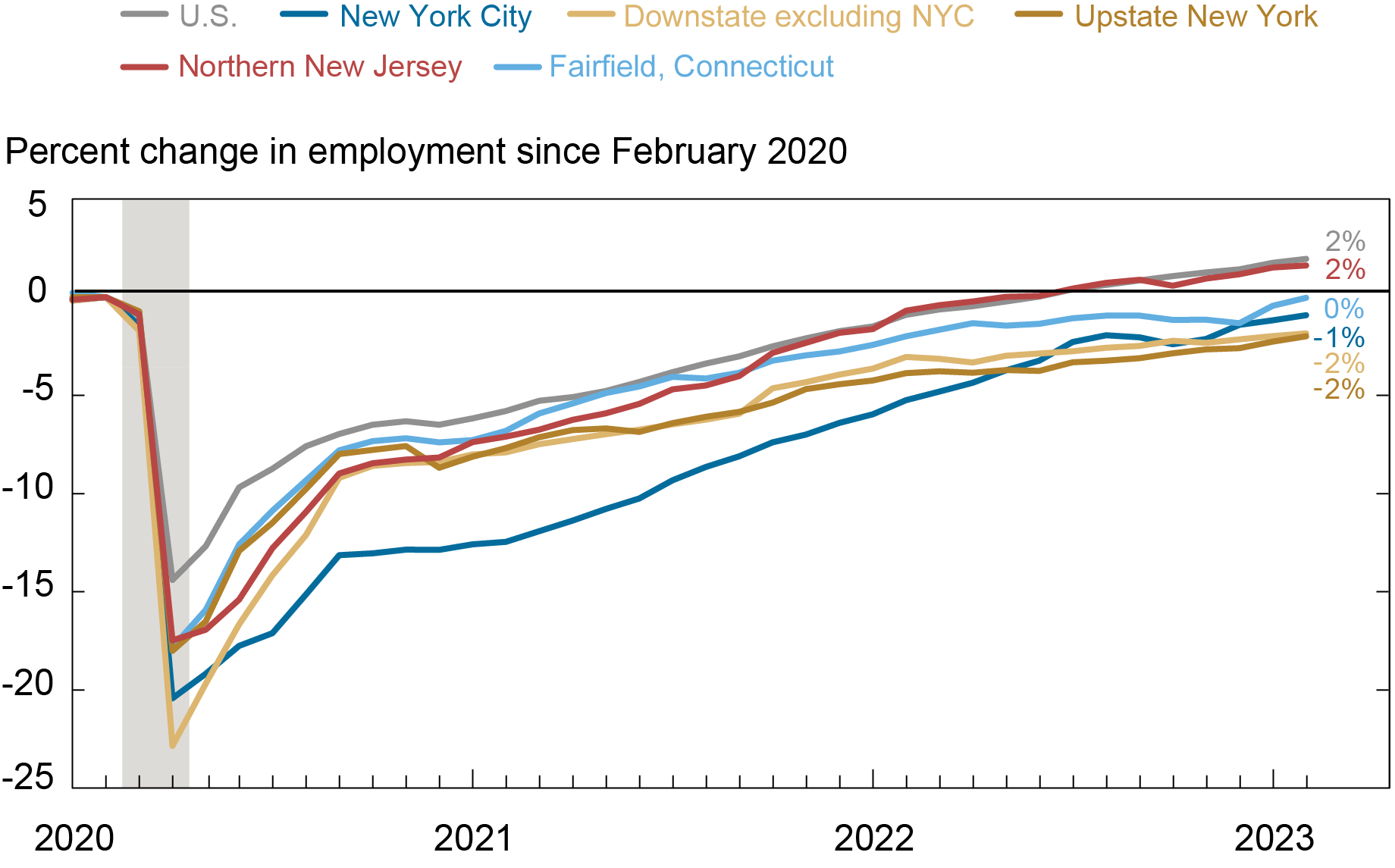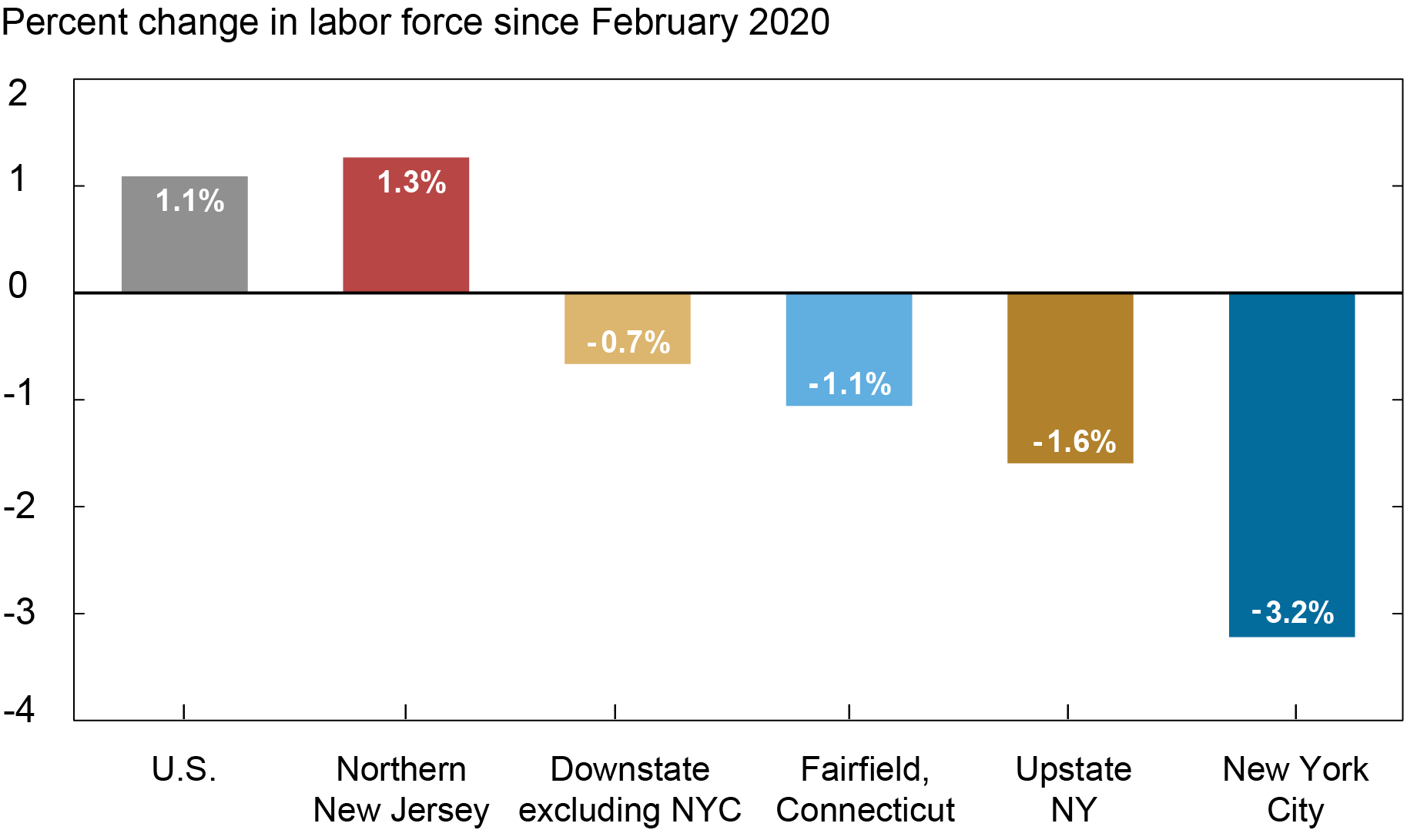
The tri-state region’s economy was hit especially hard by the pandemic, but three years on, is close to recovering the jobs that were lost. Indeed, employment initially fell by 20 percent in New York City as the pandemic took hold, a significantly sharper decline than for the nation as a whole, and the rest of the region experienced similar declines, creating a much larger hole than in other parts of the country. Three years later, the recovery has been uneven: Recent job growth has been particularly strong in New York City, where employment remains just slightly below pre-pandemic levels, and in Northern New Jersey, which has more than recovered all of the jobs lost early in the pandemic. But it has been sluggish in downstate New York outside of New York City, and in upstate New York, and employment across the region has clearly not reached the level implied by pre-pandemic trends. A dearth of available workers remains a significant constraint on growth in the region, particularly in upstate New York, which had already been suffering from a lack of workers well before the pandemic began
An Uneven Recovery
While the U.S. has seen job counts rise above pre-pandemic levels, the same can only be said about some parts of the tri-state region, as shown in the chart below. In Northern New Jersey, job growth has matched the national pace and, as in the U.S., employment is now 2 percent above pre-pandemic levels. And with a recent surge in employment, Fairfield County has now essentially regained all the jobs that were lost early in the pandemic. However, the rest of the region has not fully recovered. Employment in New York City remains 1 percent below pre-pandemic levels, although given how much the city suffered during the onset of the pandemic, its recovery has been remarkable. Job growth across the rest of New York State has been considerably weaker, especially over the past year, leaving a 2 percent job shortfall.
An Uneven Recovery from the Pandemic Recession

Note: Shaded area indicates a period designated a recession by the National Bureau of Economic Research.
While all areas have seen significant net job gains since the pandemic recession, the regional economy has undergone significant change. Many of the jobs that were lost early in the pandemic were not in the same sectors of the economy as where the gains have been. The table below shows the change in employment by industry for the U.S. and the major areas in the tri-state region between February 2020 and February 2023. There has been substantial churn and restructuring that has some common features across places, as well as some notable differences, that help explain the nature and degree of the employment recovery across the region. Significant job shortfalls exist in sectors that require face-to-face contact with customers, such as leisure and hospitality, personal services, and retail, while jobs in transportation and warehousing and business services have grown strongly above pre-pandemic levels, both nationally and across much of the region.
Significant Job Shortfalls Remain in Many Sectors
Employment Change, Feb. 2020 to Feb. 2023 (Percent)
| U.S. | Northern New Jersey | Fairfield, Conn. | New York City | Downstate Ex-NYC | Upstate New York | |
| Transportation and warehousing | 15 | 13 | 12 | -4 | 1 | 14 |
| Business services | 7 | 3 | 2 | 2 | 4 | 2 |
| Information | 6 | 10 | 4 | 2 | -13 | -12 |
| Construction | 3 | 2 | 12 | -8 | 1 | 8 |
| Education | 3 | 15 | 9 | -2 | -10 | -6 |
| Finance | 3 | 3 | -4 | 2 | 0 | -5 |
| Wholesale trade | 3 | 1 | 6 | -7 | -5 | -3 |
| Health | 2 | 4 | 2 | 10 | -1 | -6 |
| Manufacturing | 2 | 1 | 2 | -13 | -1 | 1 |
| Retail trade | 0 | -1 | -6 | -11 | -5 | -1 |
| Government | -2 | -4 | -5 | -3 | -3 | -4 |
| Personal services | -2 | -6 | -3 | -5 | -6 | -6 |
| Leisure and hospitality | -2 | -2 | 0 | -8 | -2 | -4 |
A Full Recovery in Northern New Jersey and Fairfield County
As in the U.S., job growth in Northern New Jersey and Fairfield County has been broad based. The transportation and warehousing sector play a particularly large role in the Northern New Jersey economy, and employment in the sector is 13 percent higher in that area than before the pandemic and has grown similarly in Fairfield. Employment in the education sector is also well above pre-pandemic levels in both places, and construction jobs are up in Fairfield. However, significant job shortfalls exist in sectors that require face-to-face contact, including the personal services and retail sectors, and the leisure and hospitality sector in Northern New Jersey. Notably, Fairfield has recovered jobs lost in the leisure and hospitality sector, though a significant job shortfall remains in the area’s key finance sector.
Remarkable Progress in New York City
While New York City shed more than 20 percent of its jobs when the pandemic hit and struggled to gain its footing early on, its recovery three years later has been impressive. In the last year alone, as employment grew strongly, New York City erased 5 percentage points from its job shortfall. There has been a strong bounce-back in leisure and hospitality jobs after a whopping two-thirds were lost early in the pandemic. Health care jobs are growing strongly as well, and are now 10 percent above pre-pandemic levels, and employment in the City’s key finance and business services sectors is above pre-pandemic levels. However, many sectors still have large job shortfalls. In particular, the lack of office workers has created persistent weakness in the leisure and hospitality, personal services, and retail sectors.
Sizeable Shortfalls in New York State Outside of New York City
Considerable job shortfalls remain in many sectors in downstate New York outside of New York City, as well as in upstate New York. Indeed, among large U.S. metro areas, Rochester ranks third and Buffalo ranks tenth in terms of largest job shortfalls, at 3 percent and 2 percent, respectively. And some smaller metro areas in the region have particularly large shortfalls, with Dutchess-Putnam at 7 percent, Elmira at 6 percent, and Utica at 4 percent. As in other places, the leisure and hospitality, personal services, and retail sectors all have significant job deficits, as does the education sector. The health care sector has a significantly large job shortfall upstate, where it has been difficult to fill many lower-paying jobs in nursing homes and hospitals. The information sector, which includes jobs in publishing and telecommunications, is small but has large job shortfalls both upstate and downstate. By contrast, upstate has seen strong gains in the number of jobs in transportation and warehousing, and in construction, and employment in business services is above pre-pandemic levels both upstate and downstate.
Worker Shortages Remain Challenging
While the region continues to make progress at differing rates, many businesses have struggled to find workers since the pandemic began, particularly for jobs that require face-to-face contact and are not conducive to remote work, and this continues to be a challenge. Indeed, worker shortages are holding back growth in parts of the region with the largest job shortfalls. As shown in the chart below, the labor force remains 3.2 percent below pre-pandemic levels in New York City, just over 2 percent below in upstate New York, and 1.2 percent below in Fairfield. New York City’s strong employment growth in recent months suggests that in addition to drawing residents back, it is pulling some commuters from outside the City back to the City’s jobs. Some of these jobs may also be filled by people working remotely, which increased notably during the pandemic. Labor shortages have been a chronic problem in upstate New York, where labor force growth was scant well before the pandemic, reflecting the region’s long-standing sluggish population growth. Meanwhile, as it has in the nation as a whole, the labor force has risen above pre-pandemic levels in Northern New Jersey.
Workers Hard to Find in Much of the Region

Progress Is Being Made
The tri-state region’s economy had a particularly large hole to dig out of, and, consequently, its recovery has taken longer than average. Three years after the pandemic began, jobs are continuing to come back, though many of these jobs are not the same as the ones that were lost. Of note, jobs in transportation and warehousing have grown strongly through the pandemic, while jobs requiring face-to-face contact that are not conducive to remote work have been slower to come back. Employment in New York City is growing rapidly, and Northern New Jersey and Fairfield have recovered to employment levels seen before the pandemic. However, job growth in New York State outside of New York City has been sluggish over the past year, with ongoing labor shortages a constraint on its recovery. More workers will be needed to achieve a full recovery, especially in this part of the tri-state region. However, the aging of the population, which is particularly acute in upstate New York, may pose some constraints on growth through reduced labor force participation.

Jaison R. Abel is the head of Urban and Regional Studies in the Federal Reserve Bank of New York’s Research and Statistics Group.

Jason Bram is an economic research advisor in Urban and Regional Studies in the Federal Reserve Bank of New York’s Research and Statistics Group.

Richard Deitz is an economic research advisor in Urban and Regional Studies in the Federal Reserve Bank of New York’s Research and Statistics Group.

Jonathan Hastings is a research associate in Urban and Regional Studies in the Federal Reserve Bank of New York’s Research and Statistics Group.
How to cite this post:
Jaison R. Abel, Jason Bram, Richard Deitz, and Jonathan Hastings, “The Tri‑State Region’s Recovery from the Pandemic Recession Three Years On,” Federal Reserve Bank of New York Liberty Street Economics, April 13, 2023, https://libertystreeteconomics.newyorkfed.org/2023/04/the-tri-state-regions-recovery-from-the-pandemic-recession-three-years-on/
BibTeX: View |
Disclaimer
The views expressed in this post are those of the author(s) and do not necessarily reflect the position of the Federal Reserve Bank of New York or the Federal Reserve System. Any errors or omissions are the responsibility of the author(s).













 RSS Feed
RSS Feed Follow Liberty Street Economics
Follow Liberty Street Economics